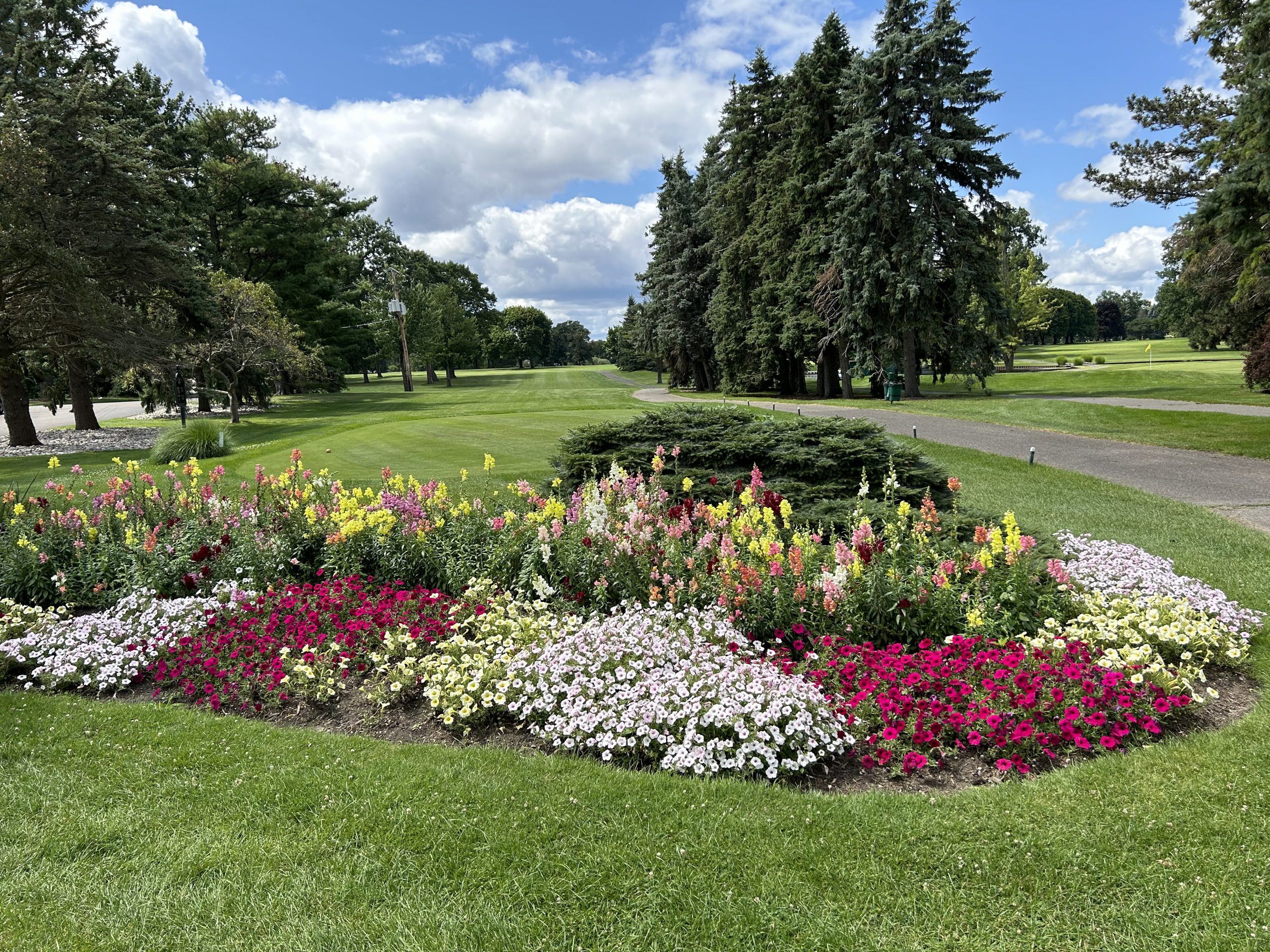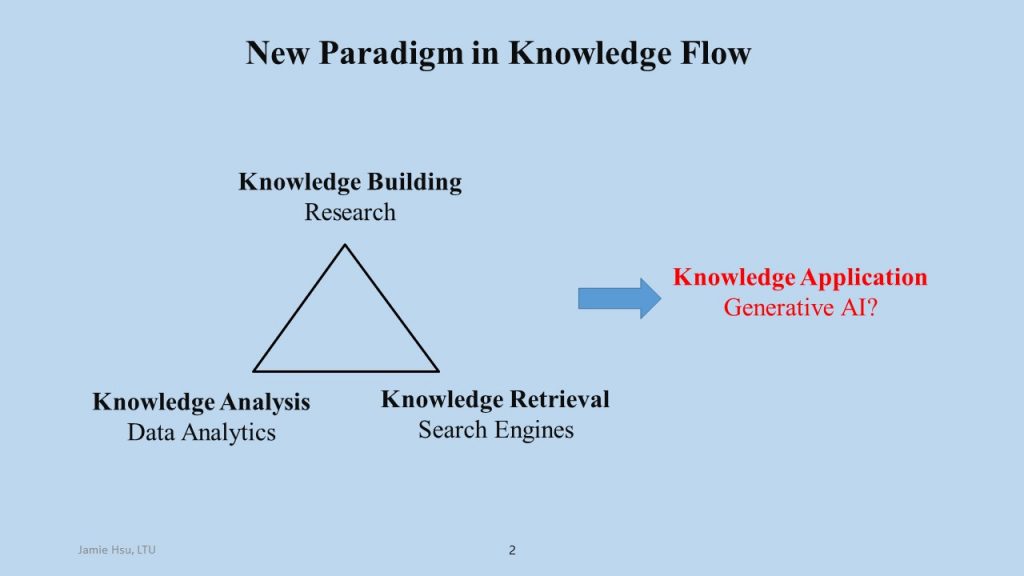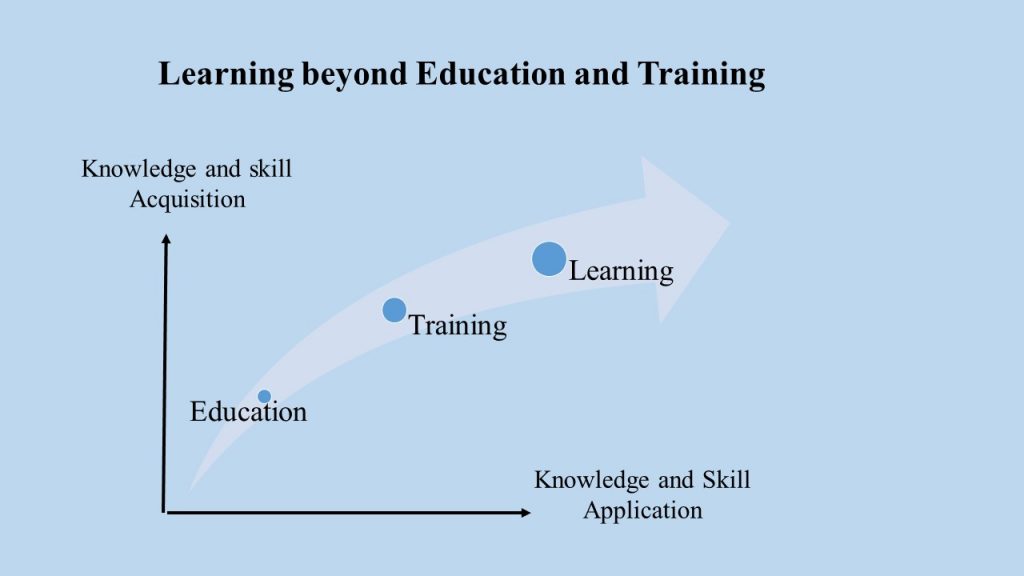
160. Learning beyond Education and Training | 學習,不止於教育和訓練
– Musings of Dr. Jamie C. Hsu, 7.22.2024
In our lifetime, we continuously acquire and apply knowledge to our work, to raise our family, and to develop ourselves. In doing so, we become better people and add value to the society we live in.
But such a process of gaining and applying knowledge has gone through significant changes with technology (Slide 1). We used to acquire knowledge from elders like parents and teachers. Now we can easily gain it with Google searches and vast internet sources. In the past, knowledge was stored in people’s minds, books, and libraries. Now we have Wikipedia and computer storage. In addition, such knowledge is transmitted via various social media and mass online courses. Only the first and last legs of the knowledge flow, its creation and application, are still human-based and human-driven.
To achieve knowledge acquisition and application, we rely on the mechanism of education, training, and continuous learning (Slide 2).
In a typical life, as a toddler, one learns most of the skills of walking, eating, and living by trial and error. Then one gets 12-14 years of formal education to gain the basic knowledge and skills of math, language, engineering, science, and the humanities. After the period of formal adolescent education, we work as adults and apply our knowledge and skills to earn a living. Some lucky ones will get further training from work or the community and develop additional skills to enhance their ability and upward mobility to achieve better economic status.
But the formal education and the short-term training may not be adequate for equipping us to face the changing environment, technology, job demands, and personal growth needs. We need “Continuous Learning” to supplement our education and training. We must continuously assess our strengths and weaknesses, future opportunities and threats, and our own needs, to implement “Continuous Learning” in our lives.
Do you have the need, the drive, and the plan to grow yourself day by day, year by year? To become a better person in your family and in life, and also become a more valuable person in your business and in society?


學習,不止於教育和訓練 (2024/07/22)
-作者 許俊宸博士
-中譯 薛乃綺
在我們的一生中,我們不斷地獲取和應用知識, 用到工作上、養育家庭,和自我發展。通過這樣做,我們成為更好和更有用的人,並且在生活中增加对社會的價值。
但是,这个獲取和應用知識的過程,已經因為技術演進而發生了重大變化(看第一張圖片)。我們過去從長輩如父母和老師那裡獲取知識,現在可以透過Google搜索或廣大的網路資源輕鬆獲取知識。過去,知識儲存在人們的頭腦中、書籍和圖書館中。現在我們有維基百科和電腦存儲。此外,這些知識通過各種社交媒體和線上大規模的課程傳播。只有知識流動的最初和最後一段:即知識的創造和應用,仍然是以人為基礎、並進行驅動的。
為了實現知識的獲取和應用,我們依賴教育、培訓,再加上“持續學習”的機制:(看第二張圖片)。
在一般生活中,作為孩童,我們大多在不斷地錯誤嘗試中,學會走路、吃飯和基本生活的技能。接下來,我們接受12到14年的正規教育,以獲得數學、語言、工程、科學和人文的基本知識和技能。在正式的青少年教育期間之後,我們成為成年人開始工作,應用我們的知識和技能來謀生。一些幸運的人將從工作或社區獲得進一步的培訓,發展額外的技能,以增強他們的能力和向上流動,實現更好的經濟地位。
但是,正規教育和短期培訓可能不足以使我們充分應對變化的環境、技術、工作需求,和個人成長需求。我們需要“持續學習”來補充自身的教育和訓練。我們必須不斷評估在手上的優勢和劣勢、未來的機會和威脅,以及我們自己的需求,以在生活中實現“持續學習”。
你有沒有這樣的需求、動力和計劃,讓自己每天、每年都在成長?如此,你在家庭和生活中,會成為一個更好的人、在職涯和社會中,也會成為更有價值的人。


